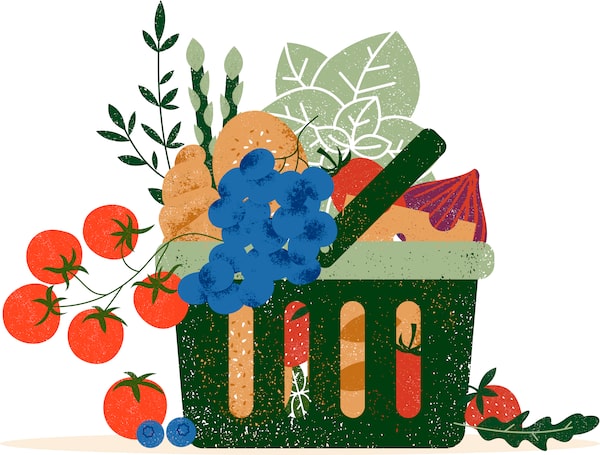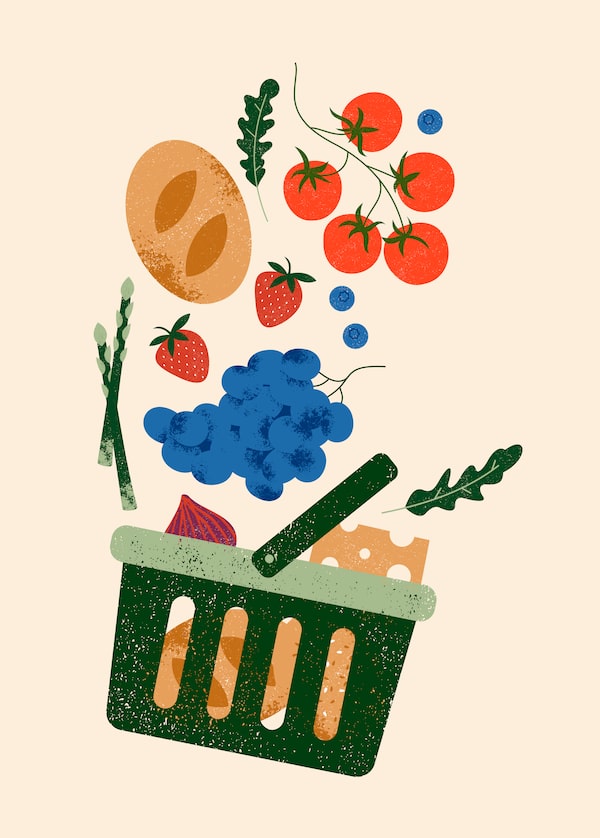
Illustration by Illustration by The Globe and Mail, Sources: iStock
Most Canadians – 80 per cent, in fact – said it was a personal goal in 2022 to make more sustainable choices when it comes to buying food, clothing and other essentials. Nearly half of them also said they are willing to pay a premium for products that are kinder and gentler for the environment.
These findings in a March survey by American Express show there is a clear commitment on the part of Canadians to do their part when it comes to taking better care of this fragile ecosystem we call Earth. Sadly, however, good intentions mean nothing unless we are willing to follow through on the execution – and one area we continue to fall woefully short is in the kitchen, where we can do better in terms of how we shop, cook and eat.
Here’s a little known fact: Canadians throw out one in every four bags of groceries they bring home. And according to food-rescue charity Second Harvest the total value of all lost or wasted food in Canada is a staggering $49-billion a year – and $10-billion of that is at the consumer level. Then think of all the energy and water wasted to grow, harvest, transport and package it. Once it ends up in landfills, and rots, it creates some 56.6-million tonnes of carbon dioxide-equivalent emissions, as well as methane gas which the Toronto-based charity says is “25 times more damaging to the environment than carbon dioxide.”
We need to do better – and we can do better, says Christine Tizzard, ambassador of a national zero-waste initiative called Love Food, Hate Waste. “But it takes time, effort and discipline to shop, eat and cook sustainably,” says the author who penned the popular 2021 cookbook Cook More, Waste Less. “I have learned there is only one thing we have immediate, direct control of: our own consumption habits.”
So, what exactly does ‘sustainable’ in the kitchen mean?
It’s a term, after all, that brands and companies are slapping on all kinds of products with no clear definition, leaving many consumers confused. In essence, sustainability means meeting our own needs without diminishing the Earth’s natural resources, thus helping future generations meet their own needs.
When it comes to the kitchen, sustainability means making eco-friendly choices on any number of fronts: taking reusable totes to the grocery store, cleaning with green products, cooking with induction (it’s more energy efficient than electric or gas), throwing as little as possible out (composting the rest, and putting it in your garden), growing some of your own food, becoming a locavore and adhering to the 100-mile diet, using apps such as Too Good To Go (which connects customers to restaurants and stores with unsold food) and Olio (people in communities post surplus food they can’t use or don’t want), and expanding your cooking repertoire so you know how to make delicious meals out of lowly food scraps.
As Tizzard says: “Even simple, small shifts can make a significant difference to the amount of food waste we produce … and if going zero-waste feels unattainable, remind yourself regularly, as I do, that it is a goal and not a hard target.”
Step 1: Shake up your shopping habits
Some love that big, bulk Costco run, while others shop every day. Tizzard says most people’s problem is their eyes are too big for their stomach and they buy too much food, which leads to more of it in the trash. According to Second Harvest, the average Canadian household spends $1,766 annually – nearly $5 a day – on food they will throw out.
To mitigate that waste, Tizzard suggests doing a “pre-shop” in your own kitchen. By that she means look in your fridge and and in your pantry before heading to the store. “Then I take stock of what needs to be used up first. I cross-reference this with the staples I have on hand and I make a meal plan. Only then do I decide what’s missing. That’s what I shop for, along with any other day-to-day essentials I’ve run out of.”
Bruce McAdams, associate professor in the School of Hospitality, Food, and Tourism Management at the University of Guelph, says he, too, has worked hard at becoming a more disciplined shopper. “Instead of buying what we want, we should be buying what we need, which isn’t always easy. But it is a shift that everyone who wants to be a more sustainable shopper needs to make, especially if they want to do their part to cut back on food waste.”
For instance, McAdams says, bread is one of the highest household waste items. (According to Vancouver-based Zero Waste Initiative, Canadians throw out 650,000 loaves of bread a day). “So I shop for bread that is ‘flexible’ which means I can use it for sandwiches, toast or even hamburgers. Most foods and ingredients aren’t single-purpose after all, we can use them for multiple things.”
Step 2: Try on a flexitarian menu

Illustration by Illustration by The Globe and Mail, Sources: iStock
The biggest impact we can make is buying more plants and less meat – or as Tizzard suggests, trying to adopt a more flexitarian way of eating where meat might play second or third fiddle to fruits, vegetables, legumes and grains. (A 2019 United Nations report on climate change found a person who eats a plant-based diet produces 50-per-cent less carbon dioxide, uses 13 times less water and uses 18 times less land than a meat-eater. That saves 1,100 gallons of water, 30-square-feet of forested land and 9.1 kilograms of CO2 equivalent every day).
“I am not vegan or vegetarian. I would say we are a plant-forward family,” says Tizzard, who estimates 70 per cent of their weekly meals are now plant-based. “It is just the way I cook now. The change in our house has been so gradual that I don’t think the rest of my family realizes just how much their diet has changed.”
It’s a trend that is catching on. The National Research Council estimates nearly 40 per cent of Canadians are incorporating more plant-based foods in their diets, and by 2024, it predicts plant-based meat alternatives will make up one-third of the market for protein products. (A recent Globe and Mail story cast some doubt on whether meat analogues will reach that goal since the products have not caught on the way manufacturers hoped).
Step 3: Respect your budget
There is a downside to eating sustainably today: A recent study from the Agri-Food Analytics Lab at Dalhousie University, in partnership with BetterCart Analytics, found plant-based products are on average 38-per-cent more expensive than animal-based equivalents, despite ever-rising meat prices.
Tizzard says eating sustainably sourced food – whether it’s organic, grass-fed, pasture-raised, free-range or fish with the Marine Stewardship Council sticker – is going to cost you more, which means it can be a stretch for lower-income families. “I advocate for eating as sustainably as you can within your budget,” she says. “But we also need to be smarter and how we’re cooking and eating things.
“Organic eggs are going to be more expensive than conventional eggs, but maybe don’t have scrambled eggs every morning. If you want a grass-fed steak, treat yourself once a week. We’re in this society where everything is so easily accessible that we are over-eating, we’re over-shopping and with the rising cost of food, we not only need to be more discerning shoppers, but also more discerning cooks and eaters.”
She advocates using a simple food rotation system. “Perishable food gets eaten first,” Tizzard says. “Get creative and make something fabulous with leftovers. Boil a chicken carcass and vegetable parts you would normally throw away to make stock. Freeze what you can’t eat right away. And learn about best-before dates, which are about quality not safety.”
According to Health Canada’s Food Safety website, you can eat and even buy after the “best before” date has passed, though the product may have lost some of its freshness, flavour and nutritional value, and its texture may have changed. Apps such as Fridgely notify you when the food in your fridge or pantry is about to expire and suggest recipes to use it up.
Step 4: Shop locally and eat seasonally
Todd Perrin, chef and owner of Mallard Cottage in St. John’s, says one of the most important things you can do is minimize food miles, which means taking a jaunt to your local farmer’s market or produce stand. “To me, sustainable and local are one and the same,” says Perrin, whose award-winning eatery regularly earns a spot in the list, published annually, by Canada’s 100 Best Restaurants magazine. “Essentially if it’s in your own backyard what can be more sustainable than that?
“You assume people are growing things in an ethical way but once you start bringing things that are out of season from halfway across the world, well then you know, it’s probably not a good thing. To us, sustainable means we know the people who grow the food, we know the intrinsic value of the food, and we use it all up.”
The key to planning sustainable meals, Perrin believes, is teaching people how to cook simple recipes with every-day ingredients. “When people learn to cook, they learn the confidence in the kitchen to transform raw ingredients into a meal that is better for them and for the environment, too.”
7 ways to make a big impact
Here are a few tips from Second Harvest, Canada’s largest food rescue organization, on how to be an eco-friendlier shopper and home cook.
1. Do a quick kitchen audit. Before you go to the grocery store, take a good look in your fridge, freezer, pantry, cupboards and drawers. Any perishable items such as fruits, vegetables, meat, poultry and dairy should be eaten first. Write them down on a list.
2. Research recipes with items that need to be eaten. Eating the items at the back of your cabinet or freezer shouldn’t be a chore, so don’t make it one. Find a great recipe (foodgawker.com is an excellent resource) and make a meal to celebrate the ingredients. For example, if you have squash and frozen broth that need eating, make squash soup. Write down any extra ingredients you may need – and double-check first that you don’t already have them.
3. Make a meal plan. By now, you should have a list of what food items you have, what needs to be eaten and a couple of recipes that you’d like to try along with ingredients that may be missing.
4. Write a missing items grocery list. Make a shopping list based on your meal plan and kitchen audit. Some items such as milk, bread and eggs, for example, may be staple items on your grocery list and can be added to every list.
5. Eat before you shop. It might sound silly but part of establishing more sustainable grocery shopping and eating habits is to buy only what you need. Just like going to an all-you-can-eat buffet on an empty stomach, you’re more likely to over-consume at the grocery store if you’re hungry.
6. Stick to your meal plan as best you can. You’ve done all the hard work of doing a kitchen audit, writing out what needs to be eaten, recipes and missing ingredients and making a meal plan – so honour the time spent by sticking to it.
7. Save your leftovers. Work your leftovers into your meal plans if you can. If you know that you’re making lasagna, for example, with noodles, canned tomatoes and carrots that all needed to be eaten, there’s a good chance that you’ll have leftovers. Make another dinner of it a couple of nights later (to give yourself a break from it).
Plan your weekend with our Good Taste newsletter, offering wine advice and reviews, recipes, restaurant news and more. Sign up today.
 Gayle MacDonald
Gayle MacDonald